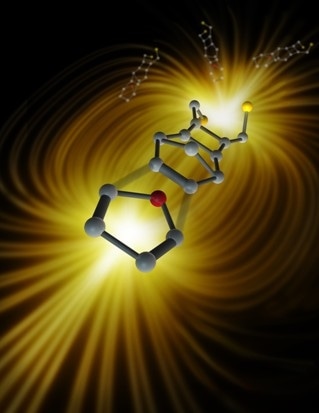Mar 4 2016
Researchers at the University of Barcelona (UB) and two universities in Australia have introduced a new way of catalysing-speeding up- chemical reactions by applying an electric field between the reacting molecules.
 This image shows the first-ever catalysis of a chemical reaction in a nanoscale junction using an electric field, which could revolutionise the way we produce chemicals for daily life applications.
This image shows the first-ever catalysis of a chemical reaction in a nanoscale junction using an electric field, which could revolutionise the way we produce chemicals for daily life applications.
This opens the door for the fabrication of chemical compounds, used in pharmaceutical products and materials, in a fast and cheaper way. The reaction studied, published at the scientific jounral Nature, was a classical Diels-Alder reaction that was promoted by applying an oriented electric field between two nano-electrodes containing the reacting molecules. This novel nano-chemical synthesis approach involves joining individual molecules to create new molecular backbones just like snapping “Legos” together, and might lead us to more efficient methods for the synthesis of challenging chemical compounds.
“Theory suggested that many chemical reactions – and not just redox (electron transferring) reactions, as is often thought – might be catalysed by applying an electric field,” says Ismael Díez-Pérez, assistant professor at the University of Barcelona and senior researcher at IBEC, who led the study published in Nature today. “We’ve provided experimental evidence for this for the first time.”
Being able to catalyse chemical reactions is essential, as it speeds up the reaction and thus makes it more proliferate – and therefore cheaper to use – in its many applications. Electrostatic catalysis (the use of electric fields) is the least developed form of catalysis in synthetic chemistry, because electrostatic effects are strongly directional. The researchers in Spain and Australia overcame this by using state-of-the-art single molecule techniques that are based on scanning tunnelling microscopy. “Our modified STM approach allows recording direct signatures of individual molecules reacting”, says Albert Cortijos, a FPU-PhD candidate at UB. “By controlling the orientation of the molecules with respect to the electric field, we accelerated a non-redox reaction for the first time,” adds Ismael.
“Using external electric fields as the ‘catalyst’ in this way means that challenging chemical reactions can be achieved that otherwise might not be possible by classical synthetic methods”, adds Nadim Darwish, a Marie Curie Research Fellow at UB. “This opens the door for future chemical technology”.